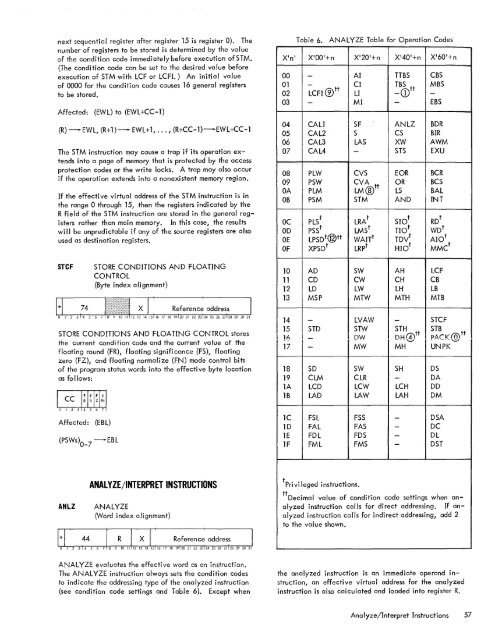1. xerox 560 computer system - The UK Mirror Service
1. xerox 560 computer system - The UK Mirror Service
1. xerox 560 computer system - The UK Mirror Service
Create successful ePaper yourself
Turn your PDF publications into a flip-book with our unique Google optimized e-Paper software.
next sequential register after register 15 is register 0). <strong>The</strong>number of registers to be stored is determined by the valueof the condition code immedi ate Iy before execution of STM.(<strong>The</strong> condition code can be set to the desired value beforeexecution of STM with LCF or LCFI.) An initial valueof 0000 for the condition code causes 16 general registersto be stored.Affected: (EWL) to (EWL +CC-1)(R)-EWL, (R+1)-EWL+1, ... , (R+CC-1)-EWL+CC-1<strong>The</strong> STM instruction may cause a trap if its operation extendsinto a page of memory that is protected by the accessprotection codes or the write locks. A trap may also occurif the operation extends into a nonexistent memory region.If the effective virtual address of the STM instruction is inthe range 0 through 15, then the registers indicated by theR field of the STM instruction are stored in the general registersrather than main memory. In this case, the resultswill be unpredictable if any of the source registers are alsoused as destination registers.Table 6. ANALYZE Table for Operation CodesX'n' X'OO'+n X'20'+n X'40'+n X'60'+n00 - AI TTBS CBS01 - CI TBS tt MBS02 LCFI ®tt LI -CD -03 - MI - EBS04 CAll SF ANLZ BDR05 CAL2 S CS BIR06 CAL3 LAS XW AWM07 CAL4 - STS EXU08 PLW CYS EOR BCR09 PSW CYA tt OR BCSOA PLM LM@ LS BALOB PSM STM AND INTOC PLS t LRAt SlOt RDtOD psst LMst TIot WDtOE LPSDt@tt WAITt TDyt AIOtOF XPSD t LRPt HIOt MMC tSTCFSTORE CONDITIONS AND FLOATINGCONTROL(Byte index alignment)10 AD SW AH LCF11 CD CW CH CB12 LD LW LH LB13 MSP MTW MTH MTBSTORE CONDITIONS AND FLOATING CONTROL storesthe current condition code and the current value of thefloating round (FR), floating significance (FS), floatingzero (FZ), and floating normalize (FN) mode control bitsof the program status words into the effective byte locationas fo lIows:14 - LYAW - STCF15 STD STW STH STB16 - DWnl-l(A)tt- .. ~ .17 - MW MH UNPK18 SD SW SH DS19 CLM CLR - DA1A LCD LCW LCH DD1B LAD LAW LAH DM- --.. '-.::/PArI( (ffittAffected: (EBL)(PSWs)0_7 -EBL1C FSL FSS - DSA1D FAL FAS - DC1E FDL FDS - DL1F FML FMS - DSTANLZANAL YZEjlNTERPRET INSTRUCTIONSANALYZE(Word index alignment)tPrivileged instructions.tt Decimal value of condition code settings when analyzedinstruction calls for direct addressing. If analyzedinstruction calls for indirect addressing, add 2to the value shown.ANALYZE evaluates the effective word as an instruction.<strong>The</strong> ANALYZE instruction always sets the condition codesto indicate the addressing type of the analyzed instruction(see condition code settings and Table 6). Except whenthe analyzed instruction is an immediate operand instruction,an effective virtual address for the analyzedinstruction is also calculated and loaded into register R.Analyze/Interpret Instructions 57
















